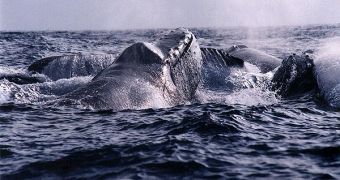Whales could feel insulted when we call an overweight person "whale", because, unlike people, these mammals move a lot.
In fact, the longest movement of any mammal, as a recent research detected, belongs to humpback whales which migrate over 5,100 miles (8,300 km) from their feeding areas off Antarctica to the mating zones off Costa Rica.
This record route is unchallenged by any mammal and few birds have longer migration journeys.
Other populations of humpback whales migrate less, but this is linked to the conditions of the eastern Pacific.
Whales feed in the cold waters, where they find the huge concentration of small oceanic creatures (especially krill) they need in order to achieve enough food. But the baby whales are born with a thin isolating fat layer, so they must be delivered in warmer waters and fed there till they get their own isolating fat layer.
In the same waters, whales also perform their mating. Otherwise, the offspring would die of hypothermia.
"It was very exciting because for years everyone said humpback whales could be found in warmer waters during the winter months, but this was the first time we were actually able to quantify this on a global scale, and relate it to these long distance migrations", said lead author Kristin Rasmussen, a biologist with Cascadia Research Collective.
The team tagged individual whales on their wintering area off Central America and then re-detected them on their feeding areas off Antarctica. This way, they found the whales covered a distance of approximately 8,300 kilometers (5,157 miles).
The particular long distance of the humpback whale migration on the eastern Pacific is due to the Humboldt current that carries the cold water off Antarctica across the whole western coast of South America, so the whales encounter warm water just off Costa Rica.
A similar situation occurs in the eastern Atlantic, where those humpback whale populations must also migrate from off Antarctica to beyond equator in the Guinea Gulf during the winter, as Benguela Current pushes cold waters to the Equator on the western African shore. "This study was possible thanks to the availability of reliable, high-resolution sea-surface temperature data collection that cover even the most remote regions of the globe," said Daniel Palacios, an oceanographer working out of NOAA's Southwest Fisheries Science Center laboratory in Pacific Grove, California.

 14 DAY TRIAL //
14 DAY TRIAL //